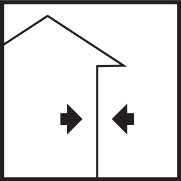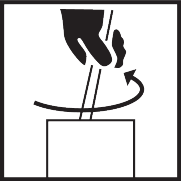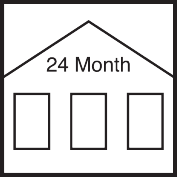Article No. 767001
Long life, cloth-matt stain with excellent UV protection for use on interior and exterior wood





Product specifications
On delivery
The stated values represent typical product characteristics and are not to be construed as binding product specifications.
Field of application
- For use on interior and exterior wood
- Dimensionally stable wood building elements: e.g. windows and doors
- Wood building elements with limited dimensional stability, e.g. folding shutters, matchboarding, summerhouses
- Wood building elements with no dimensional stability: e.g. fences, framework, carports, planking
- Playground equipment
- Wooden beehives, bee boxes and other wooden elements used in beekeeping
Properties
- Water-based with a very low solvent content
- Block resistant (in accordance with Code of Practice HO.03)
- Non-drip
- Weather resistant
- Bee-friendly formula
- Vegan - no additives of animal origin
- High level of UV resistance and colour stability
- Long intervals between renovations
- More ecological and sustainable than conventional products thanks to the use of bio-based binders
- Made from at least 80% renewable raw materials
- Classified as non-spontaneously combustible according to EPH test report*
-
Preparation
-
Substrate requirements
Dimensionally stable wood building elements: wood moisture content 11-15%
Wood building elements with limited or no dimensional stability: wood moisture content max. 18%
The substrate must be clean, dry, free of dust, grease and loose substances, and prepared in the correct manner.
-
Preparations
Thoroughly remove any dirt, grease and non-adhering old coatings.
Sand grey and weathered wood surfaces down to sound, bright wood.
Remove loose knots and any surface resin with a suitable product (e.g. Remmers Thinner & Brush Cleaner).
In order to avoid the use of wood preservatives as far as possible, the construction should be designed to be water-repellent (avoid horizontal surfaces, open end-grain wood, capillary joints, water and moisture accumulation points, contact with splash water, sharp edges). Pre-treatment with Wood Impregnation [eco] improves the hydrophobic effect.
Thoroughly sand any old coatings that are still intact.
Exterior wood that needs to be protected against soft rot and blue stain must be pre-treated with a suitable wood preservative* (*Use biocides safely. Always read the label and product information before use).
Observe BFS Code of Practice No. 18 "Coatings on Wood and Wooden Working Materials in Outdoor Areas".
-
-
Application
-
Stir well.
Apply material evenly with a brush or by spraying.
Apply in the direction of the grain.
Air-mix spraying: nozzle size: 0.28-0.33 mm; material pressure: 70-90 bar, atomiser air pressure 1-2 bar.
Airless spraying: nozzle size: 0.28-0.33 mm; material pressure: 70-90 bar.
Flow cup gun: nozzle size: 2.0 - 2.5 mm; atomiser air pressure: 2.0 - 3.0 bar.
Apply a second coat once the first has dried.
Apply a further coat if required.
Apply several coats of the corresponding colour to end-grain surfaces to prevent them from absorbing water. Alternatively, protect end-grain surfaces by applying End-Grain Wood Preservative after the colouring primer coat.
All colours can be mixed with one another.
When coating continuous surfaces, only use materials with the same batch number as slight differences in colour, gloss and texture may occur.
Seal opened containers well and use contents as soon as possible.
-
Application instructions
-
Check colour, adhesion and compatibility with the substrate by setting up a trial area.
Before coating technically modified woods and wood-based materials, apply the product to a trial surface and conduct a suitability test on the desired area of use.
Cut end-grain surfaces at the bottom to create a water-drip edge.
Each layer of stain results in a more intense colour and a glossier finish.
Rainfall may cause water soluble substances to bleed from wood that is rich in such substances, e.g. oak, red cedar, afzelia, redwood, etc. This may lead to the discolouration of light-coloured masonry or render.
Substances in oak may bleed, causing dark discolouration, when coated with water dilutable dispersion stains.
Areas that are being coated or dried should be protected against rain, wind, sunlight and condensation.
Only use the clear and white versions for exterior surfaces that are not exposed to direct weathering, such as soffits, etc.
Due to the different covering properties of white and pastel varnish colours, the optical appearance may vary depending on the substrate. It must be checked in advance whether discolouration of the varnish may occur due to substances contained in the wood.
Due to the low UV protection of these colour shades, shorter maintenance intervals must be expected.
In order to take account of and clarify these issues, a trial surface must be prepared in order to ensure that the surface meets expectations.
Do not use on wood impregnated with boron salts.
It should be noted that the tests carried out by EPH could not take into account all possible scenarios that might occur in practice. For example, contact of objects and media contaminated with this product, such as rags or dust, with other highly flammable agents, such as dust containing cellulose nitrate or certain solvents, could lead to conditions that result in ignition.
The product should not be applied at the same work stand as NC-based varnishes or stains. Collect any textiles soiled with the product (e.g. cleaning rags, work clothing) in fire-resistant waste containers and dispose of properly.
-
Drying
Practice values at +20 °C and 65% relative humidity.
Low temperatures, poor ventilation and high humidity delay drying.
Drying may take longer depending on the type of wood, e.g. oak, due to substances it contains.
-
Working tools / cleaning
-
Paintbrush with synthetic bristles, flat brush, flow cup gun, airless/airmix spraying equipment
Clean tools immediately after use with water and detergent.
Ensure that any residue from cleaning is disposed of correctly.
-
Storage / shelf life
-
If stored unopened in its original container in a cool, dry place and protected against frost, the product will keep for at least 24 months.
Use the contents of open containers as quickly as possible.
-
Usage
-
Approx. 80 - 100 ml/m² per coat
At least 2 coats
-
General information
-
DIN EN 71-3 "Migration of certain elements":
This product complies with the limits for the migration of heavy metals to children's toys according to DIN EN 71-3 and thus fulfils one of several further requirements for the safety of children's toys according to the EU "Toy Directive" (2009/48/EC).In principle, the product is also suitable for use on wood rich in substances (e.g. oak, robinia, acacia).
However, reactions with the water-soluble substances in the wood may occur that result in discolouration of the coating film and thus an impaired optical appearance (this is particularly true of white and grey shades).On planed larch and softwoods with a high resin content, the coating may have reduced adhesion and resistance to weathering. This is especially the case on horizontal year rings, knots and areas of winter growth that are high in resin. Maintenance must be carried out more frequently on these surfaces.
The only remedy for this is pre-weathering or very coarse sanding (P80).
If these wood types are rough-sawn, considerably longer maintenance intervals are to be expected.Observe the regulations concerning design principles for wood protection.
Do not use on horizontal surfaces without drainage slopes and without edge radius, avoid accumulated moisture.
-
-
Disposal instructions
-
Larger quantities of leftover product should be disposed of in the original containers in accordance with the applicable regulations. Completely empty, clean containers should be recycled. Do not dispose of together with household waste. Do not allow to enter the sewage system. Do not empty into drains.
-
-
Safety / regulations
-
For further information on the safety aspects of transporting, storing and handling the product and on disposal and environmental matters, please see the current Safety Data Sheet.
-
























